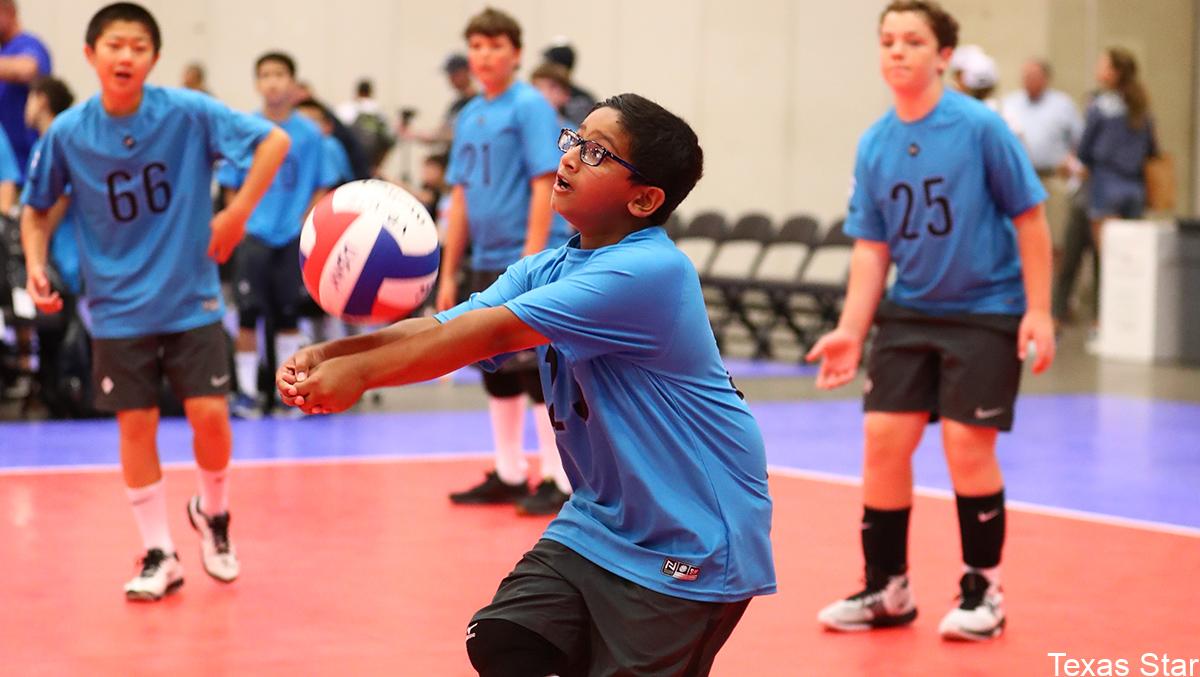
USA Volleyball has a rulebook updated annually called Domestic Competition Regulations, which follow the rules of the International Volleyball Federation (FIVB). This rulebook has a section dedicated to youth play for 3-11 year old athletes, who should be playing in teams of two or four.
Teams
Teams can be made of two, three, or four players per side.
Teams can be all one gender or coed at any percentage.
These rules can also be used to play one on one, with each player being able to hit the ball one to three times in a row, before playing the ball back over the net.
Spirit of the Rule: Substitutions are unlimited, and often should be done by “circulation.” Circulation is where the players rotate from playing to waiting out in a consistent pattern, even when the ball is in play.
Playing Area Options
Courts need to be consistent for the league and smaller than the adult sized courts. Most common options include:
- Two youth courts on one regular adult court net – four meters wide each with a two meter buffer between each court sideline, making the net buffer area with antennas, tape, swim noodles, etc. The depth per court can vary from four meters, to four and a half, to six, and for older youth nine meters. It is important to make the two meter buffer and not use a shared sideline (making the courts five meters wide with no buffer) for safety reasons.
2. Four youth courts on two linked adult nets – four meters wide and either four and a half meters deep (adult court sideline) or six meters (normal basketball court sideline).
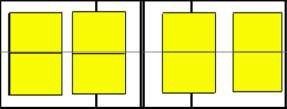
3. Three courts on one regular court using two nets tied into one.
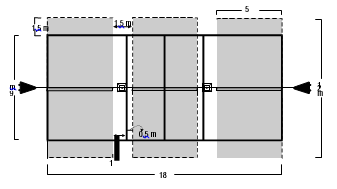
4. Racquetball Courts – Install volleyball nets in any racquetball court to create an environment where younger athletes do not have to chase the ball. Also, this environment makes big empowering noises when the ball is spiked. In addition, a racquetball court can be used to teach sitting volleyball, the Paralympic sport option.
5. Tennis Courts – Leave the net up as a divider net, string rope or nets down the court center and attach them to the fence. Then, chalk down court lines.
6. Two youth courts on two liked adult nets – six meters wide (adult end line to adult three meter line) and four and a half or six meters deep.
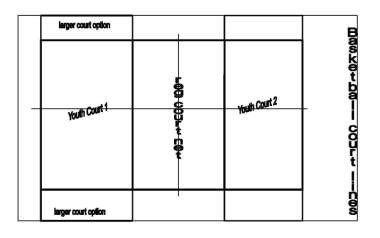
Playing Surface Options
The rule book notes that the surface must be flat, horizontal and uniform. Youth games around the world are played on city streets, concrete surfaces, grass courts, wood courts, and beach or river sand. As long as the court is consistent for both teams, play on! However, a buffer area of two meters is required around all sides of the court.
Spirit of the Rule: Lines are suggested but not required in youth volleyball. By marking just the corners allows the kids to determine the ball being in or out by consensus, including the important concept of “do over.”
Nets and balls
When possible, a net should be used, so the players can learn to play out of the net. To make more nets and save money, a simple rope can serve as a “net” for all levels of youth play.
The official ball for kids under 12, is a “light” version of the adult ball. These are adult size volleyballs which are constructed of lighter materials, and thus easier to contact for younger players. The net height for a youth program may vary, from five to six feet for younger players, to seven feet for 12 and unders. An excellent youth court option, is a badminton net/court, without extenders for younger players, and with for the older kids.
Spirit of the Rule: When making two youth courts on one adult net (indoor or portable outdoor nets), putting an antenna or some marker on the top of the net, so the edge of that court is seen is also helpful. If no such markers exist, the pole is the out of bounds court marker on one side, while the line below the net is the other marker. Regarding balls, beach balls, outdoor volleyballs, oversized volleyballs, “market” balls, and balloon balls are options, as some of these balls move slower. Both sides use the same ball.
Uniforms
Uniforms must match and be numbered 1-99.
Spirit of the Rule: For youth programs, while looking like a team is important, it is not required to have matching tops or shorts. Jewelry must be removed, except for medical alert and religious reasons.
Coach
The coach calls time outs, substitutions and determines the starting lineup order.
Spirit of the Rule: The game teaches the game, so a team is not required to have a coach to play. As that which you teach, you learn we also encourage older players, to spend time coaching the younger players in your program. There only must be adult supervision around the activity area; many great physical education moments occur when one teacher is training a class of 30 or more.
Warm Up
Optional for youth play, if your space allows you to warm up safely it is encouraged. Teams warming up should have an equal amount of time on the court. During this time, serve or side is determined, either by a coin toss or a rock-paper-scissors game. The team winning the toss can elect to serve first or pick a side and the other team then gets to pick the other option. The warm up can be shared on the same court, or one team can warm up for a short set time, two to four minutes, while the other team is off the court.
Spirit of the Rule: When warming up outside, each team helps the other team stop their spikes and/or serves, so nobody has to chase a ball far down the field or beach.
Playing Format
There are three ways to score a point
1. The opponents make an error.
2. The opponents get a penalty for poor conduct.
3. The team puts the ball down on their opponent’s court. *If an error occurs simultaneously, a replay is called, otherwise, the first fault made is the one called and errors that occur afterwards, unless a conduct violation, do not matter.
Spirit of the Rule: Transitional and cooperative scoring of a point is also an option to promote more rallying. In cooperative scoring, the ball is the opponent, and both teams work together to get as high a score as possible by counting each three contacts per side as a point. A transitional point, is scored only after the two teams rally a predetermined number of rallies across the net before a point can go up on the scoreboard.
To Win a Set
Sets, or games are played to 25 points around the world, with the wining team having to have at least a two point lead.
Spirit of the Rule: Young players, traditionally, like to play more teams for shorter matches than one team for a long time. To accommodate this, you can play to less than 25 points or start each game above zero (i.e. 10-10 and we are playing to 25).
To Win a Match
A match can be either one game, or best two out of three, with the deciding third set, if needed, being played to 15 points.
Spirit of the Rule: When a match is over before the scheduled time, let the players keep playing until the next match is on.
Rotation and Position Faults
At the moment of the serve, all starting players must be on the court or court lines, not standing outside the court. Rotation for service moves in a clockwise direction. A player may not touch any part of the opponent’s side of the court, except for with their foot or feet. As there is no center line on many courts, err in this case in keeping/teaching the players to stay away from the other team’s side, by making sure their feet are certainly partially on their own side of the court. You can unintentionally touch the net poles and guy wires.
Spirit of the Rule: Equal playing time is strongly encouraged, rather than having starters and subs. Rotating through the line up, so that players come in to serve and/or into the front row, is best.
States of Play
Ball In
The ball touches the surface of the playing court, including the boundary lines.
Spirit of the Rule: If the line bounces, the ball is good.
Ball Out
The ball touches completely outside the playing court; passes completely under the net; or touches the support lines, antenna, posts, or the net outside of the antenna.
Spirit of the Rule: The ball can touch the ceiling and play continues, unless the ball is banked in from one team to the other team’s side.
Playing the Ball
The ball may not be thrown or carried. The ball cannot be double hit, except on the first contact of your three possible hits. Unintentional double hits are allowed. The ball must be hit over the net with a maximum of three contacts. The ball can hit any part of the player’s body, including feet.
Spirit of the Rule: Let them play and let them learn the game. We should focus on the performance, over the outcome of the contact or the play. Long rallies are fun, for everyone! Hitting the ball over after one or two contacts is allowed; however, good teams work to get all three contacts.
Ball Handling Faults
1. Hitting the ball more than four times.
2. Lifting/carrying/throwing the ball.
Spirit of the Rule: Give them a lot of latitude when first learning to play, so the rallies continue and only the blatant carrying of the ball is called.
Net Play
Players may not touch the net, unless the ball drives the net into them. The ball may hit the net and continue over at any time, as long as it passes fully between the antennas.
Spirit of the Rule: The most common injury in volleyball occurs during contact at the net. Make sure to teach aggressive players to jump further back and to always stay out of the net.
Skill Specific Play
Service
This can be done by overhead action, jump/spike action, underhanded, or windmill (roundhouse). Youth players can hit the ball out of their hand, but should work towards a low and consistent toss in time. A youth player gets two chances at serve tossing, letting the ball drop to the ground if their first toss is not good. Serves can take place anywhere on the end line of your side of the court and up to five meters behind the end line if space permits. The server must hit the ball before stepping on the end line or into the court. However, you may not kick the ball for a serve.
In service, there is positive and negative errors. Download our Positive and Negative Errors PDF. The purpose of this visual is to remind players and coaches of the differences between positive and negative errors. We suggest getting them laminated and hanging one on both sides of the net during practices or clinics.
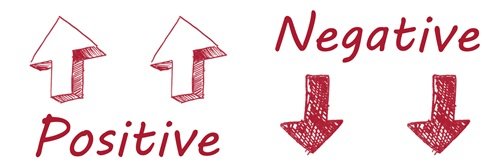
Spirit of the Rule: As some servers can dominate the game at the youth level, it is permitted to limit each server to a maximum of three to five serves before rotating and having a new server of the same team. Likewise, it is permitted to move the service line up into the court, to allow younger/weaker players to get the serve over the net. Only call service foot faults, if the player is gaining a clear advantage.
Reception/Defense
Normal ball handling rules apply, just remember that the first ball reception can be done overhead, like a set, or with a forearm pass. The ball can rebound off any surface of your body, so heading the ball, like in soccer, or even kicking up a save is allowed. The ball can be touched on or two handed as well.
Spirit of the Rule: We want to encourage hustle and effort. A good miss is playing the ball up high and/or to the center of the court. A bad miss is playing the ball over the net or on a very low trajectory.
Setting
This is the second contact by the team, most frequently placing the all up to be spiked, by using two hands. The set does not have to go the way a player is facing and can even be set behind the setting player, called a back set. This second contact is, of course, also legal if done with a forearm pass/dig. The main desire is to make the ball able to be hit.
Spirit of the Rule: When setting with both hands, give them a lot of latitude when they first start. A good miss, is setting the ball too high, too far off the net or too far inside the court. A bad miss, is setting the ball too low, too close to the net, or too far outside of the court.
Attacking
This is the act of directing the ball towards the opponent’s side. A player can jump and spike or tip, stand and set it over, forearm pass it over, etc. The tip action (one or two handed) cannot be caught or thrown over. Any one of the two to four players on a youth team may jump and attack the ball from above the top of the net.
Spirit of the Rule: Getting the attackers to start learning first off the net and running, jumping, and swinging fast. A good miss, is over the net, but out.. A bad miss, is into the net.
Blocking
A ball blocked counts as a touch, but does not count as one of the team’s three hits and can be played by a blocker without being called for a double hit. A team cannot block the serve, nor block a ball that is completely on the other side of the net (it must be hit into you, you cannot block a ball unless part of the ball is on your side of the net). In youth volleyball, only one player should jump to make a block.
Spirit of the Rule: Blocking is one of the ways to get a lead in rally scoring, by stuff blocking. However, unless the net is low enough that the blocker can get their full hand above the top of the net during their blocking action, it is better to not block at all and teach the player(s) to read and play defense. Many attacks at the youth level do not deserve a block and at most the attack needs only a one person block, taking the cross-court angle. A double block, is permitted by the official rules, but is strongly discouraged. A good miss while blocking, is not touching the ball and a bad miss is touching the net or blocking the ball out of bounds.
Injury
If an injury occurs, stop the game immediately and tend to the injured player. A replay is called. A player with a hard cast on, should not be allowed to play volleyball, even if they pad the cast. Only a small finger splint or cast, padded, which does not gain the player an advantage in contacting the ball, is allowed.
Spirit of the Rule: Volleyball is a very safe, non-contact sport. Still a sprained ankle and jammed fingers can happen. Should the team size drop below the correct number per side, due to injury or a no show, it is fine to let the team play that is short a player.
Referee
The referee stand by one of the net supports and directs the match from start to end, with their decision being final. The referee whistles for each new serve. They make the ball handling calls, in and out calls, and other judgement decisions. It is encouraged that the kids learn to referee when they are not playing in a match, with some sort of adult guidance and teaching going on at the beginning. If a referee whistles by mistake, a replay is called.
Spirit of the Rule: A referee is not required, as long as both teams are willing to call their own faults, including net contact fouls. When there is no referee play overs are important to agree on quickly, in case of a disagreement, so play can continue. A player may not contact the net at any time when there is no referee.
Parental Conduct
Athletes first, winning second. Praise in public, criticize in private. Be the most encouraging parent you know.
Paralympic, Deaflympic and Special Olympic Players
Please be a talent scout for our USA Teams with these young players. Volleyball is played in both a “Unified” and standard form for Special Olympians. An entire program and training manual for these athletes is available, go to www.specialolympics.org Athletes who are hearing impaired should consider trying out for the USA Deaf National teams, men and women, who compete every four years in the Deaflympics somewhere in the world. Finally, check out our men’s and women’s sitting, and beach ParaVolley teams. Sitting teams which train year round at the University of Central Oklahoma. The teams, men and women, compete in both the World Championships and the Paralympics, held two weeks after the Olympics in the same city,
The Spirit of Coaching Youth Volleyball Resources:
1. Catch them Doing it Right – Punishment is not necessary in youth volleyball. Volleyball is fun; the kids want to try hard and learn. So always choose encouragement and praise rather than threat of punishment to inspire and motivate.
2. I Hear & I Forget – I See & I Remember – I DO & I Understand – Kids learn by doing, not listening. When you have a choice between explaining or showing, always show briefly, then get them touching the ball as quickly as possible. Your drill should be games, and intro’s should be 30 seconds or less then get the balls in play!
3. Reward Performance over Outcome – Praise an attempt to learn a skill or the attempt to incorporate a strategy more than actual outcome. Kids who feel free to try new things become learners for life and better volleyball players.
4. Mistakes are Simply Opportunities to Teach – They are not directed at you, or done on purpose, but inherent in learning new things, and even in doing things one is already good at. Since the game is a rebound sport, but no special rebound equipment available, each player must learn his or her own way to do each skill – with your fundamental guidance.
5. Teach Positive Errors over Negative Errors – This way the learning happens faster and rallies will last longer.
6. Be Consistent – The kids need to be able to rely on you, winning, losing, succeed or erring.
7. FeedForward Works Better than Feedback – It’s human nature for all of us to willingly accept a positive encouraging reminder on what we are about to do. Our job is not to point out their past error, it is to encourage and inspire future success. Speaking to young learners about what they are about to do also teaches them to be their own coach and control their own destiny. FeedForward coaching is a collaborative in nature, the athletes can feel that you are on their side to help them succeed rather than being just another grown-up telling them what they did wrong. So, FeedForward allows your coaching to really make a difference in kids’ lives, and it also makes coaching more fun for you!



